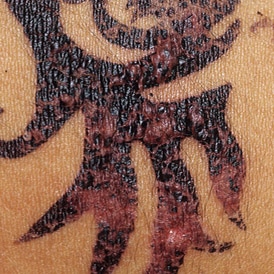Tattoo ink allergy and reactions seldom occur but is something to consider when getting a tattoo. Common causes come from the pigments used in the ink. There are a variety of heavy metals that are often used as pigments that a small portion of people are allergic to. For example, red is a color that is more likely to give allergic problems than others. Patch testing is recommended if you are concerned about getting reactions.
What is in Tattoo Ink
Tattoo ink is made of two basic components: pigments and carrier. Pigments give the solution its color. The carrier keeps the pigment in suspension, acts as an anti-bacterial/anti-viral agent and carries the pigment into the dermis. Pigments consists of a wide range of bases like iron oxides, plastics, mercury, cadmium, nickel, zinc, titanium, iron and many others. Carriers commonly used are alcohol, water, methanol, propylene glycol, glycerin and witch hazel. The most common components to give people allergic problems are pigments.
Causes of Allergy and Reactions from Tattoo Ink
Allergy and reactions from tattoo ink may occur in varying situations. The most common problems come from allergies to heavy metal pigments. For example, some people are allergic to nickel, copper, iron or cadmium and these are commonly used as pigments. Red is a color that may give people problems more than other colors. This is because red is often made with mercury and there are more people allergic to mercury than other pigments. It is estimated that between 1 and 5 percent of the general population are allergic to mercury. Yellow is often made using cadmium and cadmium may cause eczematous reactions for some people. Cadmium is also associated with reactions when exposed to light in rare cases. Cobalt, used for blues, in rare cases will cause hypersensitivity reactions and uveitis. Chromium used in greens may cause eczematous reactions within the tattoo and surrounding areas. Manganese used for purple and violet may cause tattoo granulomas. Other sources of problems may come from the aftercare products used during the healing process. MRI exams may temporarily cause tattoos to burn or sting. These reactions are rare but if you are concerned about them, ask your artist to test a small part of your skin and wait a week or two to see if you develop any reactions. Always put safety first.
Types of Reactions from Tattoo Ink
There are a wide variety of possible reactions to tattoo ink but we will cover the most common ones. Tattoo granuloma refers to cells in the exposed area of skin having a foreign body reaction. Basically, your cells see the ink as something that shouldn’t be there and is generating an immune response to it. This typically shows up as firm localized swelling in the areas where the pigment the skin is allergic to is. Granulomas are often treated with topical steroids. Eczematous reactions are another type of allergic skin problem that may occur from tattooing in rare cases. Eczematous reactions will appear as a rash that may or may not appear at the site of the tattoo. These reactions are caused if the person is allergic to one of the pigments, a common one being mercury. These reactions may be temporary or may require treatment with topical steroids.
UV Blacklight Tattoo Ink Reactions
UV blacklight tattoo ink produces a visible glow when under UV light. It produces this glow by fluorescence. Like red, some UV blacklight inks are more prone to give allergy problems. This is why, if you get a tattoo using this type of ink in a parlour, the shop will require a waver signed before it does the tattoo. This kind of ink has been steadily improving in quality and safety in recent years and the incidence of allergy problems have decreased a lot. Some artists will recommend to their customer to test a small hidden area to see if the client will have a reaction from the UV blacklight ink. We recommend this practice as it is better to wait a week and be safe than encounter skin problems later.
